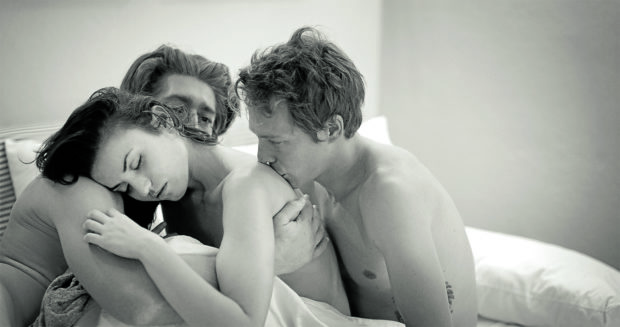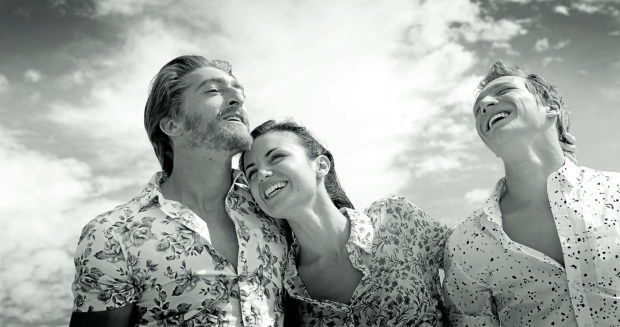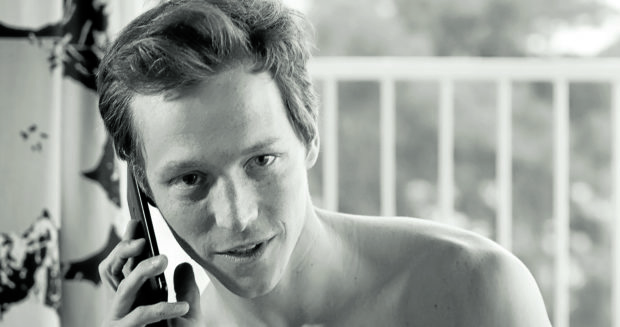‘Show Me What You Got’: Ménage à trois demystified
(First of two parts)
If Svetlana Cvetko’s visually delectable and thematically provocative ménage à trois drama “Show Me What You Got” were conceptualized and shot in the Philippines, it wouldn’t be hard to imagine TBA Studios, the maverick indie-churning production company associated with such titles as “Heneral Luna,” “I’m Drunk, I Love You,” “Lingua Franca” and “Dito at Doon,” producing it.
For TBA, it’s always been as much about artistic taste as storytelling innovation. And that is why we’ve patiently sat through every single one of its projects—from its groundbreaking innovations in filmmaking to its excusable occasional missteps.
Shot in stylish and steamy black-and-white, “Show Me What You Got,” which boasts an 80-percent approval rating on Rotten Tomatoes, plays out its unique premise and existentialist musings with as much daring as care and sensitivity.
So, it comes as no surprise that the film is being released by TBA in the Philippines and can be streamed on Upstream, KTX, iWantTFC and Ticket2Me beginning July 30.
“’Show Me What You Got’ has the kind of filmmaking excellence that TBA Studios is known for,” said CEO and executive producer Eduardo Rocha, when asked about the studio’s decision to rally behind the award-winning movie. “It’s a visually stunning film with a bold, contemporary message about love, family and relationships.
“We feel it would resonate with a lot of people, especially during these times when meaningful human connections are being halted by a pandemic. TBA Studios is proud to bring this masterpiece to the Philippines.”
The movie follows restless millennials—grieving waitress Christine di Carlo (Cristina Rambaldi), actor-personal trainer Nassim Jafari (Neyssan Falahi) and Marcello Minasi (Mattia Minasi), the rebellious heir of a famous Italian soap opera star who’s on the run from previous indiscretions—who are emboldened by a semblance of solace and security brought about by their “conscious coupling.”
But it’s the sort of off-kilter romance forged by accident more than by design. The trio’s “polyamorous arrangement” comes to a head when Marcello is forced to return to Italy—a situation that threatens to upend the delicate nature of their quickly evolving relationship.
Last week, Inquirer Entertainment spoke over Zoom to writer-director Svetlana Cvetko, writer-producer David Scott Smith, and the film’s three hot-to-trot lead stars ahead of “Show Me What You Got’s” Philippine premiere on Friday.
With the charged discussion fueled further by the team’s boundless perspicacity, it didn’t take long before we felt we were also part of a, uh, “sixsome.” How about that, Mr. Rocha and TBA? Tee-hee.
With a film that feels like a reverential nod to the French New Wave—from the movie’s seemingly improvised dialogue to its deemphasized plot—we asked Svetlana to elaborate on her decision to pursue the concept of a “throuple” and the movie’s sumptuous look.
“I began wanting to tell a story about love, and not necessarily one that transpires between two people, but just about the honest and free way of expressing love in the times that we live in. It’s also about me being adventurous in my own life,” Svetlana explained. “It kind of landed in a place where we’ve seen so many characters onscreen who are made to choose between love interests at the end of the story.
“But what if people didn’t have to choose and were just allowed to love as they pleased? What if we told that story? I was also influenced by Francois Truffaut’s 1962 film ‘Jules and Jim’ (tackling a love triangle between two friends and an impulsive woman). I always thought, ‘If that film was to be made today, how different would it be?’ Because we now live in a society that breaks the rules and does away with labels.
“As for the general look of the film, I started as a director in documentaries, but my background is cinematography. I use the skills that I developed over the years to tell stories and express emotions.
“It’s very cinema verité, which is all about being truthful without exactly being true. It’s a style that is a snug fit for a story that dares to break away from social norms. As for influence, it’s the French New Wave, as well as the Italian New Wave, [Bernardo] Bertolucci, then there’s [John] Cassavetes and his US indies—they’ve also been using this tool as a storytelling device.”
Asked about where and when the movie was shot before the pandemic, David shared, “When we added up the days, we were surprised to discover that it took only 23 days to shoot it. But that was spread out over the course of a year—because we were waiting for those precious locations, like the Joshua Tree campsite (in southeastern California) and south of Italy (in Puglia), and being able to time that perfectly where we can all be there at the same time.”
Excerpts from our Q&A with Cristina, Neyssan, Mattia, David and Svetlana:
The film wouldn’t have worked as well as it did without the right combination of truthful, convincing actors. For Neyssan, Mattia and Cristina, are you anything like your respective characters?
Mattia: I put a lot of myself in the character. Marcelo and I have a lot of things in common. We bring a lot of energy, a lot of smiles, a little bit of craziness into a room. But we also have a lot of differences.
He’s rich and lives in a bubble. He doesn’t think about other people, while I care a lot about others, sometimes too much. He fools around with girls—and that’s the only thing that makes him feel alive. And while I’m open to different experiences, I’ve never been in a threesome before the film (laughs).
Cristina: There are ways in which I feel very similar to Christine. I always say that if I were to have more courage in life and be more authentic to myself, that would be closer to who Christine is.
She knows what she wants, she isn’t afraid of anything, and she feels everything very deeply. So, playing her was definitely an exercise in courage. It was about understanding who I was so I could play her. Because that’s the thing—Christine is fully who she is.
Neyssan: As an actor, whatever character you get to play, you just find it within you. So, we have all the characters within ourselves. With Nassim, there were already similarities—from the name and background to his race.
And there were certain activities in the movie that I took from my own experience—that was my input. I haven’t really worked with refugees directly, but I’ve worked in a jail teaching acting.
Incorporating some of your own traits into your respective characters really worked well in terms of believability. But the movie also has a lot of steamy, intimate scenes? How did you break the ice?
Neyssan: Yeah, that’s a great observation. I agree with you. There was definitely an element that was very raw, very personal and very simplified in the way that we worked with each other. The characters kind of emerged from that relationship, and I feel like if I had worked with different actors, Nassim would have turned out differently. That kind of dictated the recipe that came out of it.
Mattia: Being in a threesome or in a relationship with another man was never something that I really thought about. You never really know. But the three of us got comfortable with each other even before we started the shoot.
We started spending a lot of time together, talked about our characters and different experiences. We meditated with our backs touching each other. We were trying to create this real, intimate and warm relationship. And that was love, in a way.
What do you wish the audience to take away from the film?
David: From my perspective, we hope that the audience leaves with a sense of wanting to live their life to the fullest.
Cristina: I was going to say literally the same thing. After a screening at the Santa Barbara Film Festival, an older woman came up to me in tears and just hugged me, when it was still possible to hug people (laughs).
It was bittersweet! And she said how alive the movie made her feel and how it made her realize how much freer she could have been in the past with her choices in life, but she hadn’t. Still, it gave her hope, possibly for the next generation. That encounter really touched me to the core. INQ
(Conclusion tomorrow)



